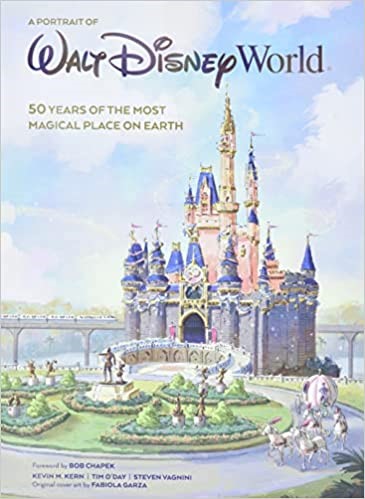Category — A Friday Visit with Jim Korkis
Fridays with Jim Korkis: The Reedy Creek Improvement District
Welcome back to Fridays with Jim Korkis! Jim, the dean of Disney historians, writes about Walt Disney World history every Friday on yourfirstvisit.net.
REEDY CREEK IMPROVEMENT DISTRICT
By Jim Korkis
At the end of April 2022, the Florida Legislature voted to dissolve the Reedy Creek Improvement District (“RCID”) by June 2023. Details are still unclear about the specifics of how that will happen, if it does, and the ramifications on the counties of Orange and Osceola, among other things.
In 1967, the creation of RCID allowed the Walt Disney Company to utilize some innovative techniques in building and to exceed the safety standards of both Orange and Osceola counties. All of this was able to be accomplished without taking any money from the taxpayers in those two counties.
Some have argued over the years that, when the Walt Disney Company abandoned the idea of building Walt Disney’s experimental city, the original reason for allowing the company such vast governing power through an improvement district was no longer necessary.
Improvement districts are not unusual, but are more common in rural areas needing things like hospitals or fire protection often unavailable in unincorporated sections. There are improvement districts in every state in the United States and over a thousand in Florida.
Basically, the government has certain responsibilities and duties to people from providing fire protection, garbage collecting, water and sewer, street lighting to other services for which people pay taxes.
However, sometimes areas need things that are not covered under those general responsiblities, cannot be easily provided, or need to be handled differently. A district can do that.
A specific boundary is established and a district is formed with the approval of a simple majority of the property owners. Once created, the district operates as a political subdivision with a Board of Directors made up of the property owners that governs the functions of that district.
These improvement districts can have wide ranging authority from imposing taxes, adopting ordinances, contract for professional services, constructing and operating improvements, handling pest control, and more. Overlaps in jurisdiction can and do occur, so coordination is necessary.
With RCID, Disney extensively communicates with local, regional, state and federal regulatory agencies on matters that cross jurisdictional lines.
There were two significant reasons for establishing the Reedy Creek Improvement District.
First, it was to ensure that Florida taxpayers would not be burdened with the cost of providing and maintaining essential public services and infrastructure required to build and operate Walt Disney World.
Second, since the original plan was to build a “community of tomorrow” on land encompassing two different counties (Orange and Osceola) that had different building standards and regulations, it was necessary to have a unified governing body that could provide the legislative and regulatory flexibility necessary to allow over the entire area innovative construction techniques from buildings to roads and water control as well as environmental protection of the area.
As early as 1969, RCID required sprinkler systems within all permanent and most temporary buildings, which was a first in Florida. It also required extensive networks of smoke and heat detectors.
Thanks to RCID, the Vista United Telecommunications system in 1978 became the first commercial fiber optic system in the United States, and then became a hundred percent digital switching network in 1983. It was the first telephone company in the state of Florida to implement a 911 emergency system.
RCID created an Environmental Services Department in 1971 and tasked them not to just maintain, but whenever possible, improve the woods, wetlands and swamps that are native to the property.
Without RCID, projects like the expansion of Disney Springs and the reconfiguration of Buena Vista Drive and World Drive would not only have required approval from Orange County officials, but they also would have been subject to the county’s budget approval process.
RCID provides Disney with the means to approve and fund such improvements expeditiously, avoiding much of the bureaucratic red tape.
The only good news is that there is still a year to try to figure things out, but whatever the outcome, it may be a whole new world.
* * * * *
Thanks, Jim! And come back next Friday for more from Jim Korkis!
In the meantime, check out his books, including his new books Vault of Walt: Volume 10: Final Edition, Kungaloosh! The Mythic Jungles of Walt Disney World and Hidden Treasures of Walt Disney World Resorts: Histories, Mysteries, and Theming, much of which was first published on this site.
Follow yourfirstvisit.net on Facebook or Twitter or Pinterest!!
June 3, 2022 No Comments
Fridays with Jim Korkis: A Portrait of Walt Disney World
Welcome back to Fridays with Jim Korkis! Jim, the dean of Disney historians, writes about Walt Disney World history every Friday on yourfirstvisit.net.
YOUR PERSONAL DISNEY LIBRARY (52)
By Jim Korkis
- A Portrait of Walt Disney World: 50 Years of The Most Magical Place on Earth by Kevin Kern, Tim O’Day, and Steven Vagnini,
My only complaint with A Portrait of Walt Disney World, a beautiful hardcover book celebrating fifty years of Walt Disney World is the same as many other Disney fans: even though the book was published in September 2021, it was challenging to get a copy until the beginning of this year, thanks to supply chain issues and problems with it being printed in China.
However, even with that caveat, A Portrait of Walt Disney World is definitely worth all the angst even though some orders from Amazon have arrived with bumped corners and sometimes a tear in the cover.
This 320 page book is, according to the publicity copy, “a robust portrait of the Walt Disney World Resort through vibrant voices and rare Disney theme park concept art, photographs and ephemera.” It certainly lives up to that description.
Unlike some “coffee table” books, this one has outstanding content to match the amazing visuals, even the smallest of which are sharp and colorful. Where else can you see background art from the 1953 Donald Duck cartoon short Don’s Fountain of Youth where the feisty fowl and his nephews visit Florida?
That’s just the beginning when it comes to treasures like multiple color photos of both Walt and Roy Disney on Walt Disney World property, early maps, design concepts (like for the Walt Disney World logo), a portrait by Charles Boyer of Dick Nunis as General Patton, and much, much more rather than the familiar images presented in previous Disney Edition books about Walt Disney World.
In addition, the text is sprinkled with quotes and memories from numerous people, including Roy Patrick Disney (Roy O. Disney’s grandchild), Debbie Dane Browne (Walt Disney World’s first Ambassador https://yourfirstvisit.net/2022/05/06/fridays-with-jim-korkis-walt-disney-world-ambassadors/ ), and many different Imagineers and others.
I would suspect the wonderful insight into the philosophy of Walt Disney World along with the accurate text is the result of the integrity and knowledge of the authors: Kevin Kern, who was manager of research for the Disney Archives; Tim O’Day, whose writing on Disney history as well as his many contributions to the Disney parks (like arranging for pardoned White House Thanksgiving turkeys getting a reprieve at the Disney parks) and Steven Vagnini, who is currently working for WDI but has had a noteworthy career at the Disney Archives, D23 and other departments.
It must have been quite a challenge to try to shoehorn a half decade of overwhelming accomplishments into the space allotted, but these authors seem up to the task. While some tangential information is obviously missing and they had to adhere to the approved Disney narrative, they were able to cover just about everything very solidly.
After the early history of the creation of Walt Disney World, the book then become neither chronological nor necessarily geographical (Magic Kingdom’s Tomorrowland is not discussed until after Disney’s Hollywood Studios) but the text continues to read so smoothly that it is not disturbing.
As you might suspect, I have a library filled with books just about Walt Disney World, but I consider A Portrait of Walt Disney World a true treasure and one that I will be using for reference in the future. The book is now easier to locate and purchase so you should consider adding it to your personal library if you have any interest in Walt Disney World and its history.
* * * * *
Thanks, Jim! And come back next Friday for more from Jim Korkis!
In the meantime, check out his books, including his new books Vault of Walt: Volume 10: Final Edition, Kungaloosh! The Mythic Jungles of Walt Disney World and Hidden Treasures of Walt Disney World Resorts: Histories, Mysteries, and Theming, much of which was first published on this site.
Follow yourfirstvisit.net on Facebook or Twitter or Pinterest!!
May 28, 2022 No Comments
Fridays with Jim Korkis: Walt Disney World and Mickeyville
Welcome back to Fridays with Jim Korkis! Jim, the dean of Disney historians, writes about Walt Disney World history every Friday on yourfirstvisit.net.
MICKEYVILLE
By Jim Korkis
Imagineer Marty Sklar always said that Imagineering never threw away any good ideas, but kept them on file to re-use later. Some people think those good ideas all appeared at Disneyland, but several of them originated at Walt Disney World and were later incorporated not only into Disneyland but Disney theme parks worldwide.
Mickey’s Birthdayland at the Magic Kingdom at Walt Disney World opened on June 18, 1988, and was intended to be just a temporary land to celebrate Mickey Mouse’s 60th birthday and have a dedicated location where guests could meet the world’s most famous mouse. Most of the structures in the land were just simple temporary facades.
However, it became so popular that it was updated to Mickey’s Starland in 1990 and shortly after inspired not only the creation of Mickey’s Toontown in Disneyland but also an area for Tokyo Disneyland that was never built.
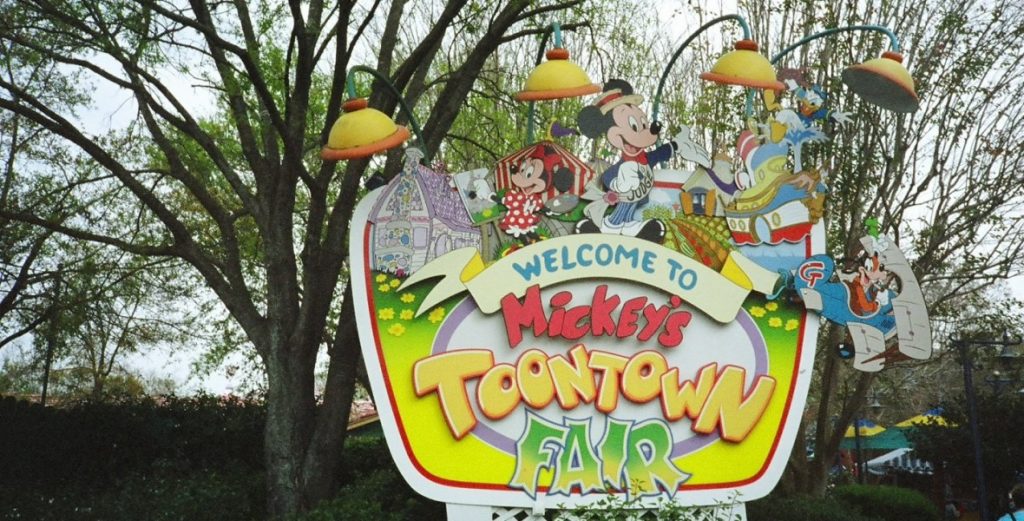
(c) Disney
Tokyo Disneyland has limited room for expansion but continually wanted to add new things. At one time, the Oriental Land Company that owns the park was seriously considering adding a Mickeyville long before the idea of Disneyland’s Mickey’s Toontown was proposed.
The original contract with Oriental Land Company allowed them to pick items for Tokyo Disneyland from both Disneyland and Walt Disney World. Roughly a year after opening Tokyo Disneyland, the Oriental Land Company was intrigued by what Walt Disney World had done.
The idea of having a dedicated area where guests could meet the costumed characters was appealing, so two Japanese designers and American Imagineer Bob Weis started doing concept work for Tokyo Disneyland’s version of the Walt Disney World area that would be called Mickeyville.
Mickeyville (to be located in the Tokyo Disneyland spot of land between Autopia and Small World) would have been based on a medieval theme using Mickey Mouse’s appearances in films like The Brave Little Tailor (1938) and Mickey and the Beanstalk (1947). Interestingly, that design work also inspired the creation of Sir Mickey’s Boutique in Disneyland Paris and later the Sir Mickey’s store at the Magic Kingdom in 1996.
The cobblestone walls and tile roofs in the artwork for Pinocchio (1940) was used as an architectural reference for Mickeyville.
Houses of various Disney animated characters would be built. Some would just be facades, while others would offer guests the opportunity to come inside and explore, such as Donald Duck’s houseboat.
The location of Donald Duck’s houseboat would have also served as a dock for the land’s only ride, for which elaborately carved wooden boats would have taken guests on a leisurely watery journey through the land.
There would have been a Minnie’s Candy Palace that looked like it was made of different candy and Mickey’s Music Store with a musical instrument decorated façade that sold CDs, sheet music and more. A large indoor Mickey Theater was to be built to showcase the elaborate stage shows popular at the park.
With a number of delays in proceeding, the Oriental Land Company discovered that a team of Imagineers at the Walt Disney Company was developing an elaborate Toontown concept inspired by Walt Disney World’s Mickey’s Starland and so decided to wait to see how that evolved. When it became a success, Tokyo Disneyland went with a version of that land in1996 that saved the Oriental Land Company both time and money.
And, of course, Walt Disney World later upgraded to Mickey’s Toontown Fair, a version of Disneyland’s Mickey’s Toontown. Mickey’s Toontown Fair was closed in 2011 and replaced by parts of New Fantasyland and Storybook Circus.
* * * * *
Thanks, Jim! And come back next Friday for more from Jim Korkis!
In the meantime, check out his books, including his new books Vault of Walt: Volume 10: Final Edition, Kungaloosh! The Mythic Jungles of Walt Disney World and Hidden Treasures of Walt Disney World Resorts: Histories, Mysteries, and Theming, much of which was first published on this site.
Follow yourfirstvisit.net on Facebook or Twitter or Pinterest!!
May 20, 2022 No Comments
Fridays with Jim Korkis: The Lego Store in Disney Springs
Welcome back to Fridays with Jim Korkis! Jim, the dean of Disney historians, writes about Walt Disney World history every Friday on yourfirstvisit.net.
THE LEGO STORE AT WALT DISNEY WORLD
By Jim Korkis
The LEGO Group is a Danish multi-national company known for toys, video games, and even theme parks, among other things. The word “Lego” comes from the Danish words “leg godt,” which means “play well.”
LEGO has produced toy lines based on Disney intellectual properties since 1999, and opened its first retail store on Disney property in October 1997 at what was then known as Downtown Disney at Walt Disney World.
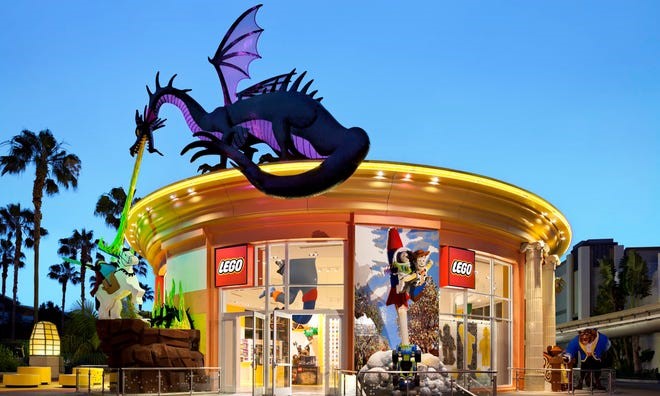
(c) LEGO
The official grand opening celebration was held November 7-9 with Master LEGO model builders appearing, as well as the presence of a twelve foot tall LEGO model of Cinderella Castle. Two decades later, a LEGO figure of Cinderella would appear outside the store.
LEGO has built eight amusement parks around the world (with Legoland Florida opening in Winter Haven, Florida in October 2011), so is technically a competitor with the Walt Disney Company.
Its first LEGO Store was in the Mall of America in Minnesota in 1992 with displays of LEGO sculptures, a play area, and a large selection of LEGO sets for sale. Its second “Imagination Center” was opened at Walt Disney World next to the World of Disney Store. Today, there are roughly ninety LEGO stores operating worldwide.
The LEGO Imagination Center at Disney Springs is over 4,400 square feet and became a popular showplace for detailed Lego models and merchandise, including a Pick and Build Wall and a Minifigure Factory. Outside the store is a 3,000 square foot play area filled with hundreds of thousands of LEGO blocks that guests can use to build their own creations.
Also outside the store are larger-than-life sculptures built from LEGOs. Director of retail and special projects Bill Higgins has stated that all the models were created by overlapping LEGO blocks. No glue was used, and no LEGO blocks were cut to fit the model.
One of the most iconic LEGO sculptures is Brickley, the twenty-foot tall, fifty-foot long sea serpent in the water outside of the store, who made his debut in 1997.
Brickley has appeared at many LEGO Stores around the world as an unofficial mascot. His eyes glow and smoke comes from his nostrils as well as from underneath his body.
In some cases like at Disneyland he works his way in and out of rooms, while other times, such as at Walt Disney World, he actually plies the waterways overlooking the store. He is comprised of over 170,000 blocks.
The character with two humps and a tail was so popular that in 2011, LEGO released two sets dedicated to Brickley. One had 59 pieces and the other, larger set had 197 pieces.
Starting with simple sculptures for photo opportunities like a snoring grandfather in a Hawaiian shirt and shorts sitting on a bench, over the decades the outside LEGO art at Walt Disney World has changed to include Prince Philip battling a towering Maleficent dragon, Woody and Buzz Lightyear using an RC Racer (and a firecracker) to soar to catch Andy’s moving van, and the Seven Dwarfs and their diamond mine, as well as Snow White giving Dopey a kiss.
In 2022, a Frozen display was added with Anna, Elsa and Olaf in their outfits from the movie Frozen II, and also added from Star Wars were Chewbacca and Rey on one side and Kylo Ren, Captain Phasma, and a red Stormtrooper on the other side.
* * * * *
Thanks, Jim! And come back next Friday for more from Jim Korkis!
In the meantime, check out his books, including his new books Vault of Walt: Volume 10: Final Edition, Kungaloosh! The Mythic Jungles of Walt Disney World and Hidden Treasures of Walt Disney World Resorts: Histories, Mysteries, and Theming, much of which was first published on this site.
Follow yourfirstvisit.net on Facebook or Twitter or Pinterest!!
May 14, 2022 No Comments
Fridays with Jim Korkis: Walt Disney World Ambassadors
Welcome back to Fridays with Jim Korkis! Jim, the dean of Disney historians, writes about Walt Disney World history every Friday on yourfirstvisit.net.
WALT DISNEY WORLD AMBASSADORS
By Jim Korkis
In June 2021, the Walt Disney World Ambassadors for 2022-2023 were announced: Raevon Redding and Ali Manion are the “Emissaries of Goodwill” to represent Walt Disney World and all Cast Members.
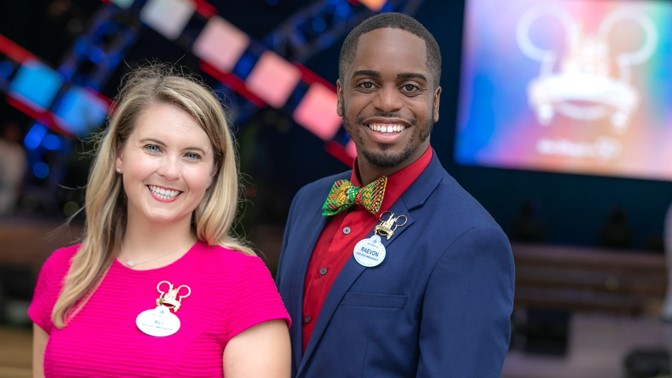
Ali Manion and Raevon Redding
(c) Disney
The park Ambassador program began in 1965 at Disneyland, when Walt Disney needed help with all the hundreds of requests for media events and hosted visits at the park for VIPs during the park’s Tencennial. It was meant to be just a one year position but the incumbent Julie Reihm was so popular and successful she was asked to remain.
When she declined so she could return to her college education, the Ambassador program was established, originally as an extension of the Guest Relations department. It has since been incorporated into every Disney theme park worldwide.
In 1970, nineteen year old Debby Dane (now Browne) became the first Walt Disney World Ambassador after working a year as a hostess at the Walt Disney World Preview Center explaining to people what Walt Disney World was going to be.
She received three months of training at Disneyland and at the Walt Disney Studio in Burbank for the Ambassador role. Her term lasted a few months longer than the normal year for Disney park ambassadors so that she could participate in the opening month activities in October 1971.
She recalled, “It was almost like the place was a child and I was watching it grow. I began to feel a part of it in many ways. I remember driving across Bay Lake after they had drained it and parking for awhile right at the middle. Now I go back and point it out to my kids and tell them how I once parked there.”
The responsibilities for the role have gotten so large that has program expanded into having multiple Ambassadors each year. After their year of service, Ambassadors often go on to other roles at Walt Disney World.
Walt Disney World Ambassadors:
- 1971 – Debby Dane Browne
- 1972 – Sherry Swets Hornsby
- 1973 – Karin Cheatham Dent
- 1974 – Christi Zeisler Aldridge
- 1975 – Suzy O’Hara Welbaum
- 1976 – Mary Ann Carter Lunde
- 1977 – Debby Bennett Griswold
- 1978 – Vicki Jaramillo
- 1979 – Pam Carpenter
- 1980 – Monica Hallecks McEwan
- 1981 – Robin Maples Davis
- 1982 – Jeanne Thiele Reynolds
1983 – Cynthia Pleasant-King - 1984 – Susan Ralston Hartnett
- 1985 – Linnae Williams
- 1986 – Jody Carbiener Dreyer
- 1987 – Elizabeth Thompson Herrin
- 1988 – Susan Anderson Kuhnlein
- 1989 – Kathleen Sullivan Riordan
- 1990 – Karen Tucker Kurth
- 1991 – Kerry Kalus
- 1992 – Dawn Kuchar Brogan
- 1993 – Kim Hursh Piercy
- 1994 – Anne Roberts
- 1995 – Rhonda Anderson, Shelby Fronzaglia, Susie Geiger, Natasha Hogan, Chris Hurt, Erin Ramsey, Michelle Reynolds, Robert Sias, Winifred Whitehouse
- 1996 – Darren Chiappetta, Sara Jones, Keith Smith, Gayle Stevens
- 1997 – Kendal Jolly, Melissa Valiquette
- 1998 – Camye Mackey, Jill Hughes, Pete Sergi
- 1999 – Maria Rodriguez, Collin Shaughnessy Conaway, Gregory Taylor
- 2000 – Kitty Byron, Kristin Vaughn McNab, Tom Thomson
- 2001-2002 – Diana Ballard, Francesca Galarraga, Steven Miller
- 2003 – Scott Hammerle, Kathleen Ochab, Wendel Philp
- 2004 – Juan Aviles, Sara Spike, Christopher Stewart
- 2005 – Jeannie Amendola, Rebecca Godsil, Christopher White
- 2006 – Marjorie Colas, Michael Collier
- 2007 – Lowell A. Doringo, Michael Kelley
- 2008 – Kerri MacPherson, TC Newman
- 2009-2010 – Vanessa Rosas, Clay Shoemaker
- 2011-2012 – Jennifer Mason, Norman Vossschulte
- 2017-2018 – Ken Facey, Brandon Peters
- 2019-2021 – Stephen Lim, Marilyn West
- 2022-2023 – Ali Manion and Raevon Redding
- WDW Honorary Ambassador (1990) – Louise Gerow, former program manager
* * * * *
Thanks, Jim! And come back next Friday for more from Jim Korkis!
In the meantime, check out his books, including his new books Vault of Walt: Volume 10: Final Edition, Kungaloosh! The Mythic Jungles of Walt Disney World and Hidden Treasures of Walt Disney World Resorts: Histories, Mysteries, and Theming, much of which was first published on this site.
Follow yourfirstvisit.net on Facebook or Twitter or Pinterest!!
May 6, 2022 No Comments
Fridays with Jim Korkis: The Art of Stars Wars: Galaxy’s Edge
Welcome back to Fridays with Jim Korkis! Jim, the dean of Disney historians, writes about Walt Disney World history every Friday on yourfirstvisit.net.
YOUR PERSONAL DISNEY LIBRARY (51)
By Jim Korkis
- The Art of Stars Wars: Galaxy’s Edge by Amy Ratcliffe
Those already familiar with the “Art of” books published by Abrams know what to expect from The Art of Stars Wars: Galaxy’s Edge: a beautiful hardcover filled with full-color concept art, informative text, interviews with people who worked on the project, and more. You can continue reading, but you already know that I highly recommend this stunning book with one minor quibble that I will mention at the end.
I imagine the reason this book was produced was not just because of Disney fans, but also the legion of rabid Star Wars fans that want to know every bit of material about the Star Wars universe.
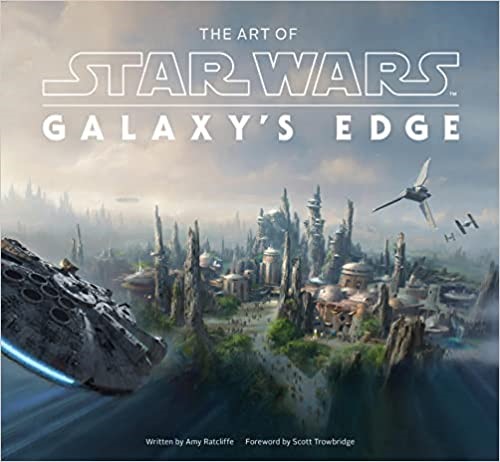
The Art of Stars Wars: Galaxy’s Edge has thirteen chapters, and I was especially excited that the final chapter goes into great detail, rather than just a cursory mention, of the new Halcyon resort hotel, sharing information that appears nowhere else in print, including that the design for the top of the hotel was meant to reference the smokestacks on a cruise ship.
Each chapter describes in elaborate detail the planning, ideas, and creation of a part of the Galaxy’s Edge world. There is background information, behind-the-scenes explanations of how it all came together, and of course, dozens and dozens of images of concept art and early designs.
More importantly, the sketches, paintings and other artwork are printed at a size where it is easy to explore the details so often missed and actually, for the most part, read the little notes. Basically, much of this material has never been seen anywhere else and probably won’t.
Author Amy Ratcliffe is the managing editor of Nerdist, also the author of Star Wars: Women of the Galaxy and The Jedi Mind, and was a contributor to From a Certain Point of View: The Empire Strikes Back. She is also a host at Star Wars Celebration as well as a regular contributor to StarWars.com and Star Wars Insider.
I liked the fact that her experience gives her a Star Wars perspective that a Disney author might have missed, and helps to make connections in the text.
Scott Trowbridge, who supplies a lengthy and informative foreword and assisted the author with this book, is the Imagineering creative executive responsible for bringing Star Wars to life globally at Disney’s theme parks, resorts, cruise lines, and entertainment experiences.
My one minor quibble? There are no photos of the actual land to compare and contrast with the artwork, nor any behind-the-scenes construction photos of things being built.
Also missing in The Art of Stars Wars: Galaxy’s Edge is any mention of the music used in the land, especially the new theme by composer John Williams. Of course, those topics have been covered here at this site but it would have been nice to see them included in this book so it would be more comprehensive.
However, I can quibble about what I would have liked to see included or celebrate what was included and be grateful. I choose gratitude.
* * * * *
Thanks, Jim! And come back next Friday for more from Jim Korkis!
In the meantime, check out his books, including his new books Vault of Walt: Volume 10: Final Edition, Kungaloosh! The Mythic Jungles of Walt Disney World and Hidden Treasures of Walt Disney World Resorts: Histories, Mysteries, and Theming, much of which was first published on this site.
Follow yourfirstvisit.net on Facebook or Twitter or Pinterest!!
April 29, 2022 2 Comments



